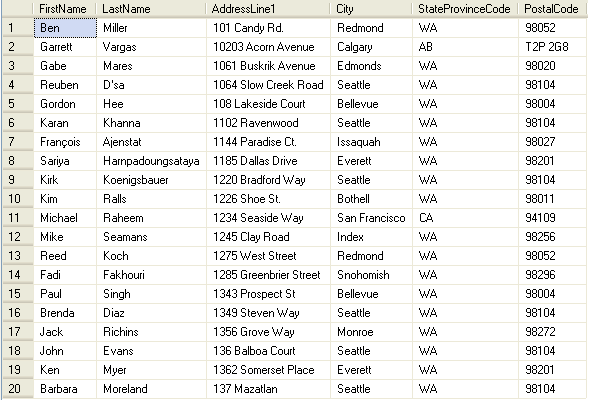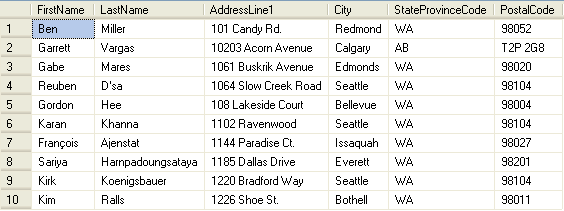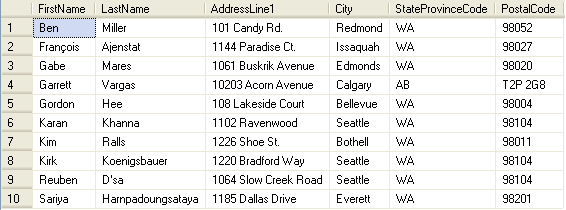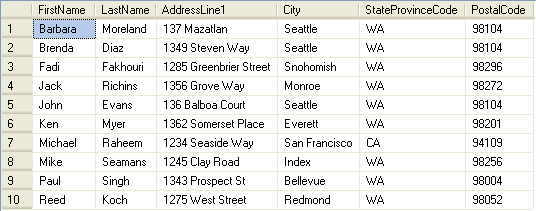By: Greg Robidoux | Comments (4) | Related: 1 | 2 | 3 | 4 | 5 | 6 | 7 | > JOIN Tables
Problem
When joining multiple datasets you have always had the ability to use the UNION and UNION ALL operator to allow you to pull a distinct result set (union) or a complete result set (union all). These are very helpful commands when you need to pull data from different tables and show the results as one unified distinct result set. On the opposite side of this it would be helpful to only show a result set where both sets of data match or only where data exists in one of the tables and not the other. This could be done with using different join types, but what other options does SQL Server offer?
Solution
With SQL Server, Microsoft introduced the INTERSECT and EXCEPT operators to further extend what you could already do with the UNION and UNION ALL operators.
- INTERSECT - gives you the final result set where values in both of the tables match
- EXCEPT - gives you the final result set where data exists in the first dataset and not in the second dataset
The advantage of these commands is that it allows you to get a distinct listing across all of the columns such as the UNION and UNION ALL operators do without having to do a group by or do a comparison of every single column.
Like the UNION and UNION ALL operators the table structures need to be consistent as well as the columns need to have compatible data types.
Let's take for example we have two tables manager and customer. Both of these tables have somewhat the same structure such as the following columns:
- FirstName
- LastName
- AddressLine1
- City
- StateProvinceCode
- PostalCode
Here is the Manager table sample data:

Here is the Customer table sample data:

We want to do two queries:
- Find the occurrences where a manager is a customer (intersect)
- Find the occurrences where the manager is not a customer (except)
SQL Server INTERSECT Examples
If we want to find out which people exist in both the customer table and the manager table and get a distinct list back we can issue the following command:
SELECT FIRSTNAME,
LASTNAME,
ADDRESSLINE1,
CITY,
STATEPROVINCECODE,
POSTALCODE
FROM MANAGER
INTERSECT
SELECT FIRSTNAME,
LASTNAME,
ADDRESSLINE1,
CITY,
STATEPROVINCECODE,
POSTALCODE
FROM CUSTOMER
Here is the result set:

To do this same thing with a regular T-SQL command we would have to write the following:
SELECT M.FIRSTNAME,
M.LASTNAME,
M.ADDRESSLINE1,
M.CITY,
M.STATEPROVINCECODE,
M.POSTALCODE
FROM MANAGER M
INNER JOIN CUSTOMER C
ON M.FIRSTNAME = C.FIRSTNAME
AND M.LASTNAME = C.LASTNAME
AND M.ADDRESSLINE1 = C.ADDRESSLINE1
AND M.CITY = C.CITY
AND M.POSTALCODE = C.POSTALCODE
GROUP BY M.FIRSTNAME,M.LASTNAME,M.ADDRESSLINE1,M.CITY,
M.STATEPROVINCECODE,M.POSTALCODE
SQL Server EXCEPT Examples
If we want to find out which people exists in the manager table, but not in the customer table and get a distinct list back we can issue the following command:
SELECT FIRSTNAME,
LASTNAME,
ADDRESSLINE1,
CITY,
STATEPROVINCECODE,
POSTALCODE
FROM MANAGER
EXCEPT
SELECT FIRSTNAME,
LASTNAME,
ADDRESSLINE1,
CITY,
STATEPROVINCECODE,
POSTALCODE
FROM CUSTOMER
Here is the result set:

To do this same thing with a regular T-SQL command we would have to write the following:
SELECT M.FIRSTNAME,
M.LASTNAME,
M.ADDRESSLINE1,
M.CITY,
M.STATEPROVINCECODE,
M.POSTALCODE
FROM MANAGER M
WHERE NOT EXISTS (SELECT *
FROM CUSTOMER C
WHERE M.FIRSTNAME = C.FIRSTNAME
AND M.LASTNAME = C.LASTNAME
AND M.ADDRESSLINE1 = C.ADDRESSLINE1
AND M.CITY = C.CITY
AND M.POSTALCODE = C.POSTALCODE)
GROUP BY M.FIRSTNAME,M.LASTNAME,M.ADDRESSLINE1,M.CITY,
M.STATEPROVINCECODE,M.POSTALCODE
From the two examples above we can see that using the EXCEPT and INTERSECT commands are much simpler to write then having to write the join or exists statements.
To take this a step further if we had a third table (or forth...) that listed sales reps and we wanted to find out which managers were customers, but not sales reps we could do the following.
Here is the SalesRep table sample data:

SELECT FIRSTNAME,
LASTNAME,
ADDRESSLINE1,
CITY,
STATEPROVINCECODE,
POSTALCODE
FROM MANAGER
INTERSECT
SELECT FIRSTNAME,
LASTNAME,
ADDRESSLINE1,
CITY,
STATEPROVINCECODE,
POSTALCODE
FROM CUSTOMER
EXCEPT
SELECT FIRSTNAME,
LASTNAME,
ADDRESSLINE1,
CITY,
STATEPROVINCECODE,
POSTALCODE
FROM SALESREP
Here is the result set:

As you can see this is pretty simple to mix and match these statements. In addition, you could also use the UNION and UNION ALL operators to further extend your final result sets.
Next Steps
- Take a look at your existing code to see how the INTERSECT and EXCEPT operators could be used
- Keep these new operators in mind next time you need to compare different datasets with like data
About the author
 Greg Robidoux is the President and founder of Edgewood Solutions, a technology services company delivering services and solutions for Microsoft SQL Server. He is also one of the co-founders of MSSQLTips.com. Greg has been working with SQL Server since 1999, has authored numerous database-related articles, and delivered several presentations related to SQL Server. Before SQL Server, he worked on many data platforms such as DB2, Oracle, Sybase, and Informix.
Greg Robidoux is the President and founder of Edgewood Solutions, a technology services company delivering services and solutions for Microsoft SQL Server. He is also one of the co-founders of MSSQLTips.com. Greg has been working with SQL Server since 1999, has authored numerous database-related articles, and delivered several presentations related to SQL Server. Before SQL Server, he worked on many data platforms such as DB2, Oracle, Sybase, and Informix.This author pledges the content of this article is based on professional experience and not AI generated.
View all my tips






